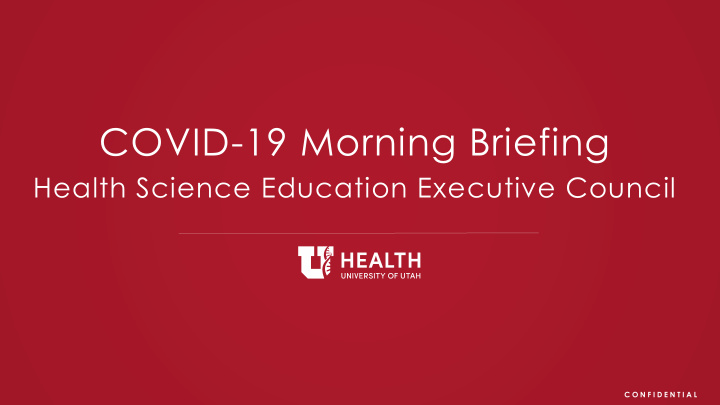



COVID-19 Morning Briefing Health Science Education Executive Council C O N F I D E N T I A L
PLANNING (4.17.2020) PLAN/PREPARE FOR A WORST CASE OPERATIONALIZE A “NEW - NORMAL” SPACE (ICU & Acute beds, etc.) Balance background of patients with • • COVID-19 (& potential for surges) with STAFF (Providers, Nurses, etc.) • new normal operations STUFF (Vents, PPE, Sedatives, etc.) • – Telehealth SECURITY • – Key resource constraints • PPE SPECIAL (TRAUMA, ONC, etc) • • Beds & ventilators • Sedating medications – COVID-related pathways/precautions • Universal masking • Testing • Effective caring & cohorting of COVID+ patients Think. Plan, and Act as One-System C O N F I D E N T I A L
Students are in the Special Category • On March 16, 2020, all students were removed from in-person clinical care. • Students are non-essential healthcare workers, yet are our future healthcare workers. • In a few months some will join our workforce. • Residents are employees and considered essential healthcare workers. C O N F I D E N T I A L
Student Type and Trajectory of Training • Practice Ready at • Further training after graduation graduation – BSN ‒ OT – Medical Students – PA ‒ PT – MPH ‒ ST – Lab science ‒ PharmD ‒ DDS ‒ DNP C O N F I D E N T I A L
How will we know when it is time for the students to engage in in-person clinical encounters? • Safety first – for patients, students and care providers. • PPE supply in excess of that needed for essential providers. • If conditions change, participation in direct patient care activities will be suspended. C O N F I D E N T I A L
Adequate PPE • Adequate surgical face masks for students to utilize one daily. • Students will not utilize N-95 masks – and not participate in activities requiring their use. • Students complete training and attest to follow policies/procedures for PPE use/re-use and conservation. C O N F I D E N T I A L
Patient Volume and Preceptor Availability • Adequate patient visits, census, and caseloads for number of students assigned to ensure meaningful learning opportunities. • Readiness of individual faculty, residents/fellows, services, and/or divisions to reincorporate students into clinical workflow. • Teams and preceptors must have adequate bandwidth to provide appropriate supervision and instruction. C O N F I D E N T I A L
Preparing for the long haul … • Students engagement in clinical care will flex up and down based on – Pandemic conditions • Safer at home • Level of hospital readiness needed – Critical resources • PPE, staffing, etc . C O N F I D E N T I A L
DRAFT – April 20, 2020 Students participate in low acuity outpatient and some inpatient rotations. Students must wear Students participate in most Students do not participate in in- surgical mask. Students must certify outpatient and inpatient rotations. person clinical care. they have taken PPE training. Students must wear surgical mask. Students should not be involved in Students participate in all clinical Students must certify they have Students engaged in online rotations. Postpone interactions with any COVID-positive or COVID- taken PPE training. Students should learning. COVID-positive and COVID- suspected patient care and should not be involved in any COVID- suspected patients, unless student not utilize N95 masks or higher level positive or COVID-suspected patient Students may be included in virtual Students submits evidence of immunity. of PPE. Online and virtual care and should not utilize N95 care and non-patient facing involvement remains. Students who masks or higher level of PPE. Online activities per program rules and are closest to graduation and have and virtual involvement remains. agreement from providers. remaining requirements have priority for placement. (No involvement in ED, urgent care)
Students do not participate with direct in-person clinical care. Students engaged in online learning. Students may be included in virtual care and non- patient facing activities per program rules and agreement from providers. DRAFT – April 20, 2020
Students participate in low acuity outpatient and some inpatient rotations . Students must wear surgical mask. Students must certify they have taken PPE training. Students should not be involved in any COVID-positive or COVID-suspected patient care and should not utilize N95 masks or higher level of PPE. Online and virtual involvement remains. Students who are closest to graduation and have remaining requirements have priority for placement. (No involvement in ED, urgent care, ICU, busy wards) DRAFT – April 20, 2020
Students participate in most outpatient and inpatient rotations . Students must wear surgical mask. Students must certify they have taken PPE training. Students should not be involved in any COVID-positive or COVID-suspected patient care and should not utilize N95 masks or higher level of PPE. Online and virtual involvement remains. DRAFT – April 20, 2020
Students participate in all clinical rotations. Postpone interactions with COVID-positive and COVID-suspected patients, unless student submits evidence of immunity. DRAFT – April 20, 2020
Each Program will assess suitability for student placements Priority placements: • Class of 2021 • Class of 2020 with remaining graduation – Medical students requirements – PA students – Physician assistant – DNP students students C O N F I D E N T I A L
Recommend
More recommend